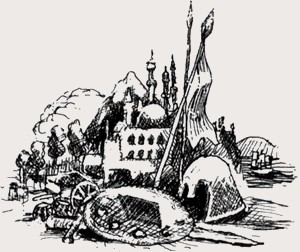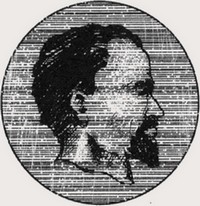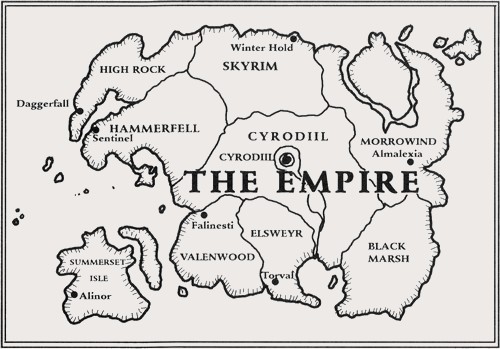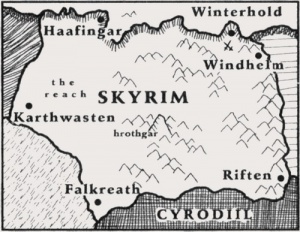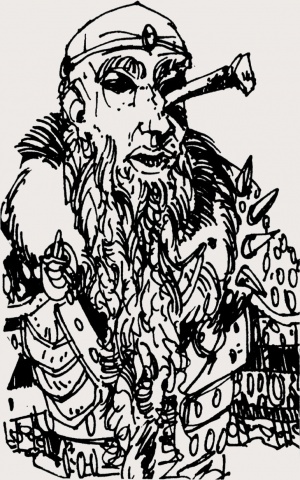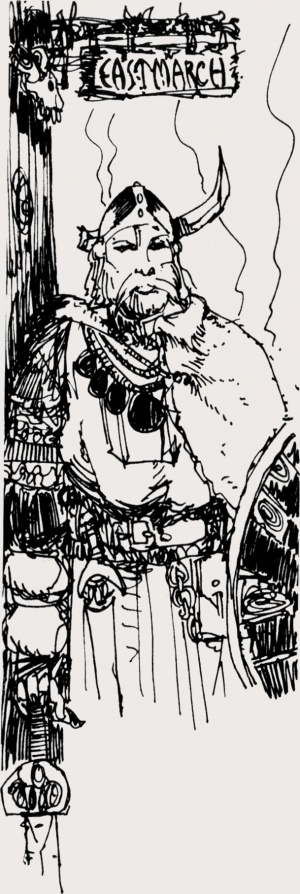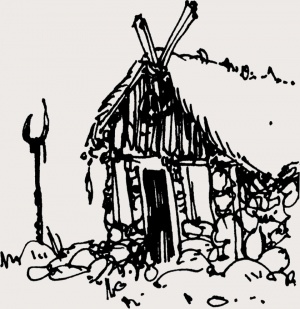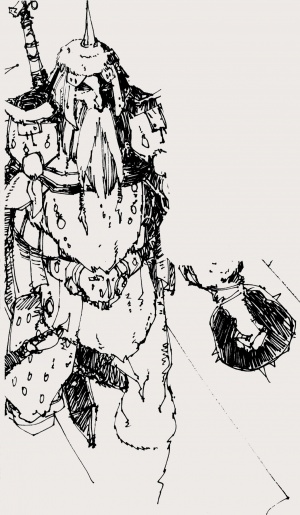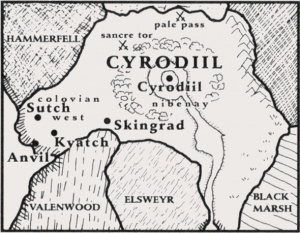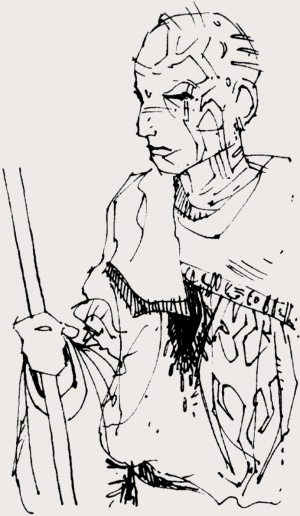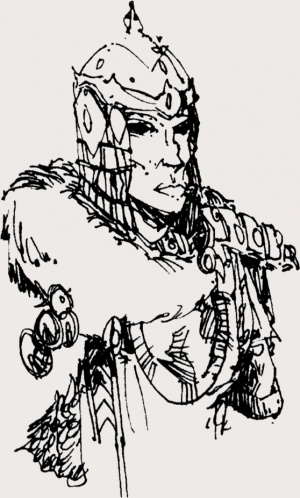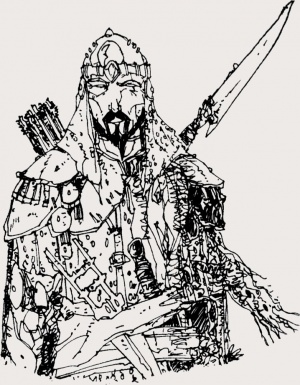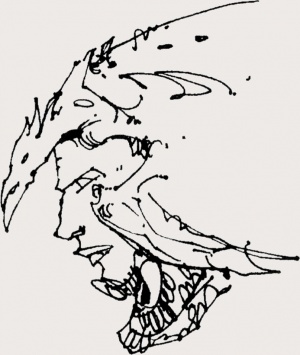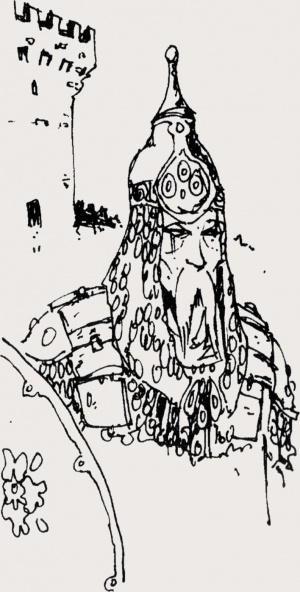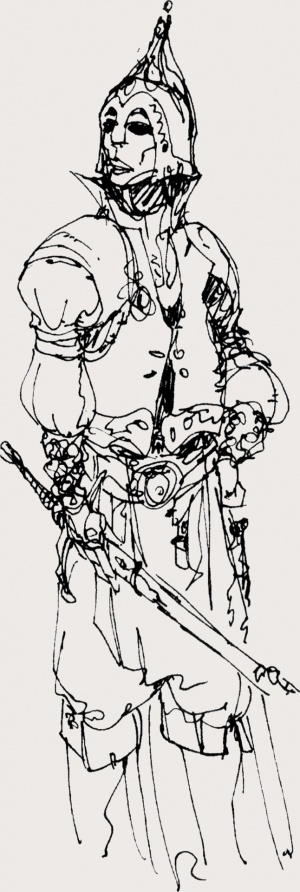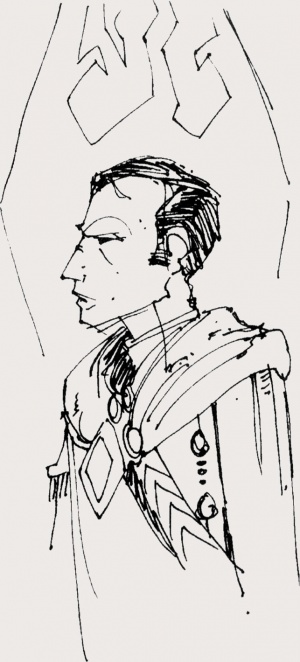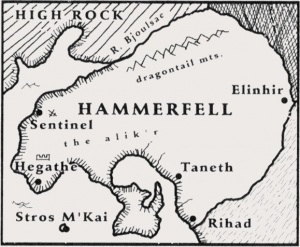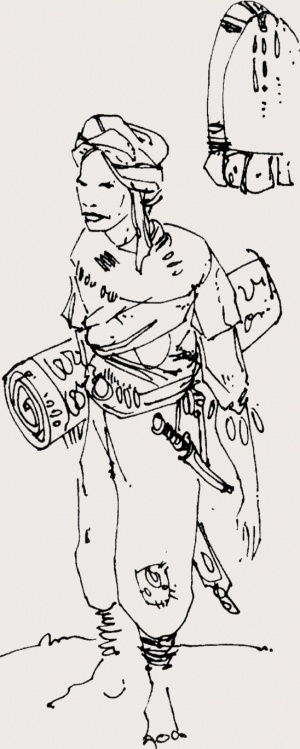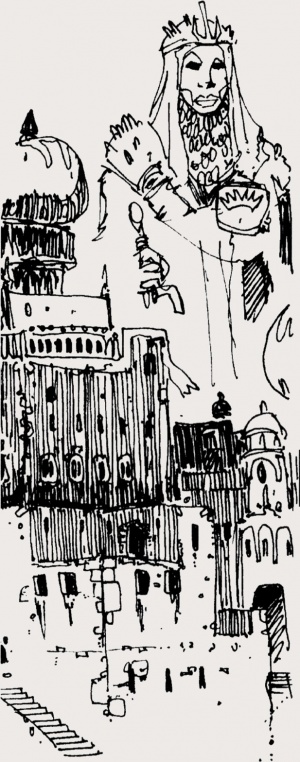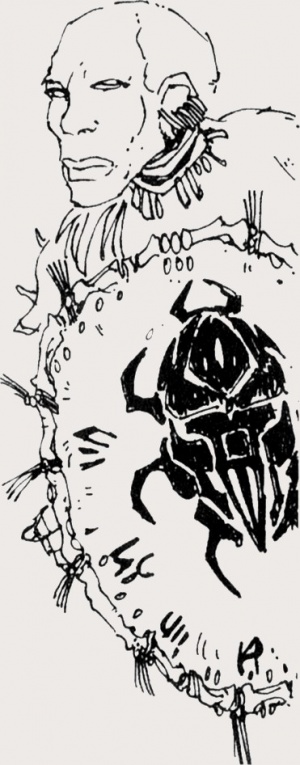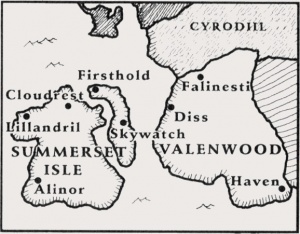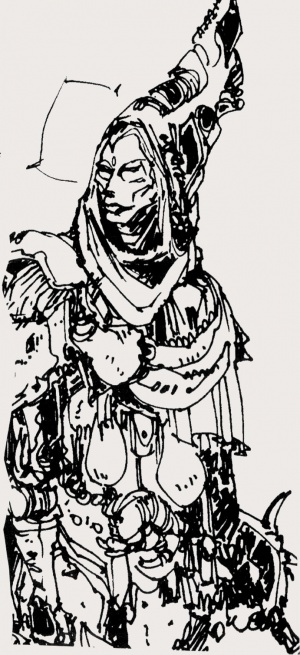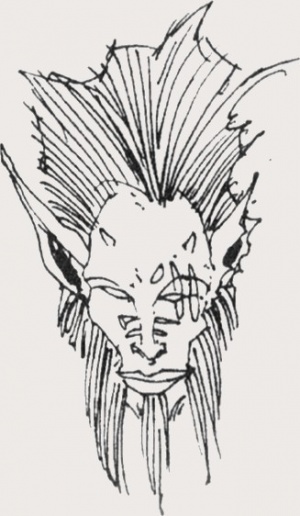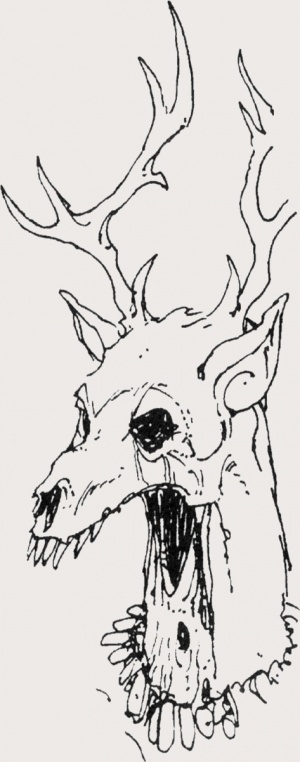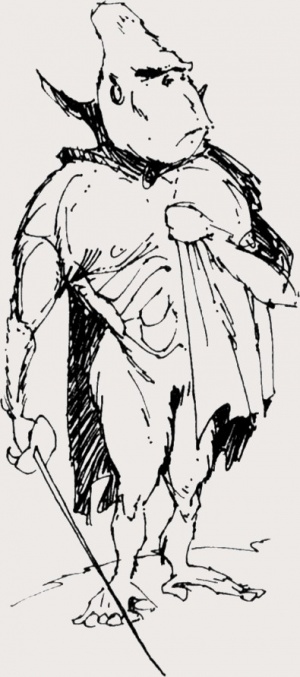Guide de poche de l'Empire, Première édition
Note : Ce livre est annoté par "YR", un elfe transmettant le présent guide à son oncle accompagné de la lettre suivante. Les annotations écrites comme ceci : Mot commenté (Annotation de YR).
Dans ce texte on peut lire plusieurs fois "CE" ou "ère courante", Il s'agit de la seconde ère.
Severest Uncle,
Before taking my post as military attache in the so-called Imperial City (a foreshadowing of the pretentions of these humans), I took your advice and made a sojourn across the Outerlands, both within this newborn Empire and those regions it has get to acquire ~
Make no mistake, Talos (now Tiber Septim in resplendant Cyrodilic) is still on the ascendant. I now believe the oracles have been badly misinterpreted - Septim may indeed be the Dragonborn as foretold. The Mer must unite at last or be consumed one by one. Father, blessed be his name's numeric mystery, was one of the few on the Thalmor to oppose Andel Crodo's policy of nonintervention that if continued will be the doom of all Elder Races. I understand that my present assignment is intended as a punishment for not following in my father's footsteps, but I urge you to overlook our personal disagreements and to relay my findings to the full Council.
I forward this pamphlet as a sample of the official propaganda from Septim's regime, annotated with my own observations, which while not tempered by age and wisdom are yet valuable as a record of a naive traveller
~YR
to
THE EMPIRE
and its environs
Being a Description of the Lands and the
Divers Customs of the Inhabitants
and furthermore a useful history of those places of interest
by Nature of their Locations & Influence.
Dedicated
To the unswerving Commitment to Truth and Knowledge
of His Most Discerning Majesty the Emperor Tiber Septim
Promulgated under the Authority of the Imperial Geographical Society
CE 864
Scions of Emperors, King of Earth and Sky,
Lord of Shining Hosts,
Protector of Oathman, Freeman and Yeoman,
Guarantor of Right and Justice,
Broad Blessing of Thrones and Powers,
Cynosure of Celestial Glory,
The Most High Tiber Septim
| The 8 Invocations and 16 acceptable Blasphemes.
To AKATOSH whose perch from Eternity allowed the Day. .noitaripsnI fo tnuoF eht HAIHTEOB oT |
Welcome, citizen!
With the dawn of a new era before us, it is time that we take stock of where we have been and where we are, in order to better illuminate the way ahead. Written in celebration of the Battle of Hunding Bay, which marked the return of all human kingdoms to the unchallenged rule (this remains to be seen) of the Cyrodilic Emperor, this pamphlet seeks to briefly describe the present provinces of the Empire and the surrounding regions-- their history, people and current condition. We strove to balance timeliness with accuracy and completeness; if we have erred in our zeal to place this valuable guide in the hands of interested citizens everywhere, we beg the kind reader's indulgence.
The Empire stretches across Tamriel, the largest known continent of the World. To the north of Tamriel is Atmora, from whence the Men of the World came. To the west is Yokuda, the lost native land of the Redguards. To the east is Akavir, whose armies invaded Tamriel in the previous era. To the south all is mystery and the whisper of a lost Elven homeland (So, even the humans have heard of Old Ehlnofey).
Tamriel itself is generally divided into eight major regions: Skyrim, Cyrodiil, High Rock, the Aldmeri Dominion of the Summerset Isles and Valenwood, Hammerfell, Morrowind, and the Elsweyr Confederacy. Some of these, such as Morrowind or Skyrim, have historically been unified into kingdoms; others, such as High Rock or Elsweyr, are looser groupings of many kingdoms, chiefdoms, village confederations, and so forth, united under a dominant race or culture. At its zenith, the Second Empire formally organized these disparate groups into the Imperial Provinces, which were administered by provincial governors, either dispatched directly from Cyrodiil or appointed from the native populations. (Morrowind is a notable exception, having never been conquered by the original Cyrodilic Empire and, thus escaping investment as an Imperial Province.). With the fall of the Cyrodilic Empire, control reverted to the individual rulers of each province, resulting in centuries of chaos, as many of the provinces devolved into independent kingdoms and petty statelets. Now, happily, all of the human kingdoms have been recovered by the Third Empire of Tiber Septim, and once again they all bear the proud title of Imperial Provinces (Breathtaking arrogance!).
The Aldmeri Dominion, the Elsweyr Confederacy, and Morrowind have yet to join the Empire, but are described in this book for the edification of the scholar, the fascination of the common citizen, and the preparation of the soldier. The Third Empire is yet in its youth, and who can predict what new horizons might yet greet the dawn under the Red Diamond Banner?
Some regions escape provincial classification due to the primitive civilization of their beastfolk inhabitants. Collectively, these beastfolk 'states' are known as the Wild Regions, which may or may not be of interest to the Emperor. They are included only for the most intrepid of travelers, and to throw the achievements of Civilization into more brilliant relief by contrast with these benighted corners of Tamriel.
Now, citizen, we entreat you to review our modest survey of the Empire's dominions. If it entertains and edifies, reflect not upon the humble labors of this scribe, but on the gracious benevolence of our beloved Emperor, whose very name is as ambrosia upon our tongues, who in his wisdom has ordained that this survey be created and distributed among the earnest and wise people of Tamriel, that they might better understand the glories and challenges of these Lands and Dominions, and that they might better appreciate the great burdens of rulership he bears in our names with such fortitude.
A note on Elven designations: The Elves as a whole are sometimes referred to as the 'Aldmeri,' or 'the Elder Races.' Their individual pedigrees (Dangerous racialism - there shall be no accomodation as with Reman.) are likewise referred to by both their human and Aldmeri names; thus, High Elves are the 'Altmer,' Dark Elves the 'Dunmer,' Wood Elves the 'Bosmer,' etc., etc. 'Mer' is also used to denote a single Elf. Words that designate an Elven member of a profession or trade can therefore correctly be said as 'craftsmer,' for example, or 'noblemer.
Skyrim, also known as the Old Kingdom or the Fatherland, was the first region of Tamriel settled by humans: the hardy, brave, warlike Nords, whose descendants still occupy this rugged land, and, although perhaps somewhat reduced from the legendary renown of their forebears of old, the Nords of the pure blood still unquestionably surpass the mixed races in all the manly virtues
Exactly when the Nords first crossed the ice-choked Sea of Ghosts from Atmora, their original homeland, is uncertain. As recorded in the Song of Return, Ysgramor and his family first landed in Tamriel at Hsaarik Head, at the extreme northern tip of Skyrim's Broken Cape, fleeing civil war in Atmora (then rather warmer than at present, as it seems to have supported a substantial population). These first settlers named the land "Mereth", after the Elves that roamed the untamed wilderness which then covered the whole of Tamriel. For a time, relations between Men and Elves were harmonious, and the Nords throve in the new land, summoning more of their kin from the North to build the city of Saarthal, the site of which has recently been located by Imperial archaeologists in the vicinity of modern Winterhold. But the Elves saw that the vital young race would soon surpass their stagnant culture (!) if left unchecked, and fell upon the unsuspecting Nords in the infamous Night of Tears; Saarthal was burned, and only Ysgramor and two of his sons (Ysgramor's provocations and blasphemies have, of course, been long forgotten ~) fought free of the carnage and escaped to Atmora. The Elves, however, had reckoned without the indomitable spirit of the Nords. Gathering his legendary Five Hundred Companions (whose names are still recited every Thirteenth of Sun's Dawn at the Feast of the Dead in Windhelm), Ysgramor returned to Tamriel with a vengeance, driving the Elves out of Skyrim and laying the foundations of the first human Empire.
It may be that the exploits of the near-mythical Ysgramor conflate the reigns of several early Nord Kings, as the Elves were not finally driven from the present boundaries of Skyrim until the reign of King Harald, the thirteenth of Ysgramor's line, at the dawn of recorded history. King Harald is also remembered for being the first King to relinquish all holdings in Atmora; the Nords of Skyrim were now a separate people, whose faces were turned firmly toward their destiny, the conquest of the vast new land of Tamriel. Indeed, the history of the Nords is the history of humans in Tamriel; all the human races, with the exception of the Redguards, are descended from Nordic stock, although in some the ancient blood admittedly runs thin.
| Snow Elves Nords attribute almost any misfortune or disaster to the machinations of the Falmer, or Snow Elves, be it crop failure, missing sheep, or a traveler lost crossing a high pass. These mythical beings are popularly believed to be the descendants of the original Elven population, and are said to reside in the remote mountain fastnesses that cover most of Skyrim. However, there is no tangible evidence that this Elven community survives outside the imaginations of superstitious villagers. Uncle, I saw signs that might be Falmer boundary-runes, but nothing sure. If any survive, they are wary and withdrawn. |
King Vrage the Gifted began the expansion that led to the First Empire of the Nords. Within a span of fifty years, Skyrim ruled all of northern Tamriel, including most of present-day High Rock, a deep stretch of the Nibenay Valley, and the whole of Morrowind. The Conquest of Morrowind was one of the epic clashes of the First Era, when ensued many a desperate contest between Nord and Dark Elf in the hills and glades of that dire kingdom, still recalled by the songs of the minstrels in the alehouses of Skyrim. The system of succession in the First Empire is worthy of note, as it proved in the end to be the Empire's undoing. By the early years of the First Empire, Skyrim was already divided into Holds, then ruled by a patchwork of clan-heads, kings, and councils (or moots), all of which paid fealty to the King of Skyrim. During the exceptionally long reign of King Harald, who died at 108 years of age and outlived all but three of his sons, a Moot was created, made up of representatives from each Hold, to choose the next King from qualified members of the royal family. Over the years, the Moot became permanent and acquired an increasing amount of power; by the reign of King Borgas, the last of the Ysgramor dynasty, the Moot had become partisan and ineffective. Upon the murder (righteous slaying) of King Borgas by the Wild Hunt (see Aldmeri Dominion - Valenwood), the Moot's failure to appoint the obvious and capable Jarl Hanse of Winterhold sparked the disastrous Skyrim War of Succession, during which Skyrim lost control of its territories in High Rock, Morrowind, and Cyrodiil, never to regain them. The war was finally concluded in 1E420 with the Pact of Chieftans; henceforth, the Moot was convened only when a King died without direct heirs, and it has fulfilled this more limited role admirably. It has only been called upon three times in the intervening millenia, and the Skyrim succession has never again been disputed on the field of battle.
The land of Skyrim is the most rugged on the continent, containing four of the five highest peaks in Tamriel (see Places of Note: Throat of the World). Only in the west do the mountains abate to the canyons and mesas of the Reach, by far the most cosmopolitan of the Holds of Skyrim, Nords of the pure blood holding only the barest majority according to the recent Imperial Census. The rest of Skyrim is a vertical world: the high ridges of the northwest-to-southeast slanting mountain ranges, cleft by deep, narrow valleys where most of the population resides. Along the sides of the river valleys, sturdy Nord farmers raise a wide variety of crops; wheat flourishes in the relatively temperate river bottoms, while only the snowberry bushes can survive in the high orchards near the treeline. The original Nord settlements were generally established on rocky crags overlooking a river valley; many of these villages still survive in the more isolated Holds, especially along the Morrowind frontier. In most of Skyrim, however, this defensive posture was deemed unnecessary by the mid-first era, and most cities and towns today lie on the valley floors, in some cases still overlooked by the picturesque ruins of the earlier settlement.
| "The Tongues" The Nords have long practiced a spiritual form of magic known as "The Way of the Voice", based largely on their veneration of the Wind as the personification of Kynareth. Nords consider themselves to be the children of the sky, and the breath and the voice of a Nord is his vital essence. Through the use of the Voice, the vital power of a Nord can be articulated into a thu'um, or shout. Shouts can be used to sharpen blades or to strike enemies at a distance. Masters of the Voice are known as Tongues, and their power is legendary. They can call to specific people over hundreds of miles, and can move by casting a shout, appearing where it lands. The most powerful Tongues cannot speak without causing destruction. They must go gagged, and communicate through a sign language and through scribing runes. In the days of the Conquest of Morrowind and the founding of the First Empire, the great Nord war chiefs - Derek the Tall, Jorg Helmbolg, Hoag Merkiller - were all Tongues. When they attacked a city, they needed no siege engines; the Tongues would form up in a wedge in front of the gatehouse, and draw in breath. When the leader let it out in a thu'um, the doors were blown in, and the axemen rushed into the city. Such were the men that forged the First Empire. But, alas for the Nords, one of the mightiest of all the Tongues, Jurgen Windcaller (or The Calm, as he is better known today), became converted to a pacifist creed that denounced use of the Voice for martial exploits. His philosophy prevailed, largely due to his unshakable mastery of the Voice -- his victory was sealed in a legendary confrontation, where The Calm is said to have "swallowed the Shouts" of seventeen Tongues of the militant school for three days until his opponents all lay exhausted (and then became his disciples). Today, the most ancient and powerful of the Tongues live secluded on the highest peaks in contemplation, and have spoken once only in living memory, to announce the destiny of the young Tiber Septim (as recounted in Cyrodiil). In gratitude, the Emperor has recently endowed a new Imperial College of the Voice in Markarth, dedicated to returning the Way of the Voice to the ancient and honorable art of war. So it may be that the mighty deeds of the Nord heroes of old will soon be equaled or surpassed on the battlefields of the present day. Septim's new college is staffed by hacks and charlatans -- the so-called Grand Master is said to have formerly earned his living as a street performer in Windhelm -- the students are scions of the most obsequious Nord families, hoping to curry favor with Tiber Septim's New Order ~ |
Nords are masters of wood and timber construction; many structures survive in use today that were built by the first settlers over 3,000 years ago. A fine example of Nord military engineering can be seen at Old Fort, one of the royal bastions constructed by the First Empire to guard its southern frontier. Towering walls of huge, irregular porphyry blocks fit together without seam or mortar, as if constructed by mythical Elhnofey rather than men.
The nine Holds present a varied aspect in people, government, and trade. The Reach could be mistaken for one of the petty kingdoms of High Rock; it is full of Bretons, Redguards, Cyrodiils, Elves of all stripes, and even a few misplaced khajiit. The northern and western Holds -- Winterhold, Eastmarch, Rift, and the Pale, known collectively as the Old Holds -- remain more isolated, by geography and choice, and the Nords there still hold true to the old ways. Outsiders are a rarity, usually a once-yearly visit from an itinerant peddler. The young men go out for weeks into the high peaks in the dead of winter, hunting the ice wraiths that give them claim to full status as citizens (a laudable practice that could serve as a model for the more "civilized" regions of the Empire). Here, too, the people still revere their hereditary leaders, while the other Holds have long been governed (after a fashion) by elected moots. It is fortunate for Skyrim and the Septim Empire that the people of the Old Holds have preserved the traditions of their forefathers. Skyrim has long been dormant, slumbering through the millenia while upstart conquerors bestrode the Arena of Tamriel. But now, a son of Skyrim (a disputed claim ~) once again holds the world's destiny in his hands. If Skyrim is to awake, its rebirth will be led by these true Nords who remain its best hope for the future.
Places of Note:
Haafingar (Solitude)
The home of the famous Bards' College, Haafingar is also one of Skyrim's chief ports, and ships from up and down the coast can be found at her crowded quays, loading timber and salted cod for the markets of Wayrest, West Anvil, and Senchal. Founded during Skyrim's long Alessian flirtation, the Bards' College continues to flaunt a heretical streak, and its students are famous carousers, fittingly enough for their chosen trade. Students yearly invade the marketplace for week of revelry, the climax of which is the burning of "King Olaf" in effigy, possibly a now-forgotten contender in the War of Succession. Graduates have no trouble finding employment in noble households across Tamriel, including the restored Imperial Court in Cyrodiil, but many still choose to follow in the wandering footsteps of illustrious alumni such as Callisos and Morachellis.
Windhelm
Once the capital of the First Empire, the palace of the Ysgramor dynasty still dominates the center of the Old City. Windhelm was sacked during the War of Succession, and again by the Akaviri army of Ada'Soon Dir-Kamal; the Palace of the Kings is one of the few First Empire buildings that remains. Today, Windhelm remains the only sizable city in the otherwise determinedly rural Hold of Eastmarch, and serves as a base for Imperial troops guarding the Dunmeth Pass into Morrowind.
Throat of the World
This is the highest mountain in Skyrim, and the highest in Tamriel aside from Vvardenfell in Morrowind. The Nords believe men were formed on this mountain when the sky breathed onto the land. Hence the Song of Return refers not only to Ysgramor's return to Tamriel after the destruction of Saarthal, but to the Nords' return to what they believe was their original homeland. Pilgrims travel from across Skyrim to climb the Seven Thousand Steps to High Hrothgar, where the most ancient and honored Greybeards (~At last, a few Men worthy of respect. I met with an ancient Greybeard who could actualy converse with me almost as an equal.~ my only such experience amon the humans so far_) dwell in absolute silence in their quest to become ever more attuned to the voice of the sky.
Cyrodiil, Dragon Empire, Starry Heart of Nirn, and Seat of Sundered Kings... Indeed, if the history of the Nords is the history of humans on Tamriel, then Cyrodiil is the throne from which they will decide their destiny. It is the largest region of the continent, and most is endless jungle. Its center, the grassland of the Nibenay Valley, is enclosed by an equatorial rain forest and broken up by rivers. As one travels south along these rivers, the more subtropical it becomes, until finally the land gives way to the swamps of Argonia and the placid waters of the Topal Bay. The elevation rises gradually to the west and sharply to the north. Between its western coast and its central valley there are all manner of deciduous forest and mangroves, becoming sparser towards the ocean. The western coast is a wet-dry area, and from Rihad border to Anvil to the northernmost Valenwood villages forest fires are common in summer. There are a few major roads to the west, river paths to the north, and even a canopy tunnel to the Velothi Mountains, but most of Cyrodiil is a river-based society surrounded by jungle.
| Alessian Order This monotheistic religion was once very popular, but today only remnants of its faith remain. It started in the coastal jungle of what is now the Colovian west, where a prophet named Marukh, who had spoken to the "Enlightened One," Saint Alessia, began to question the validity of Elven rule. These sentiments led to an increasingly abstract and unknowable depiction of a Single God. The Alessians were wise enough to realize that they had to incorporate the ancient polytheistic elements into their new religion for it to find a wide acceptance. The divine aspects worshipped by the various humans and Aldmeri were recognizable in the guise of the myriad saints and spirits of the evolving Alessian canon. It wasn't long before the Order was the authority on every religion in Tamriel, and their power grew to earthshaking proportions. Nearly a third of the First Era passed under their theocratic rule. When its priesthood had become too widespread to support itself, the Order began to fight among itself. With the severance of the territories of West Cyrodiil from the Empire, too much money and land had been lost. The War of Righteousness broke out, and the Order which had almost ruled the world undid itself in a ten year span. |
Cyrodilic history truly begins by the middle of the Alessian Reformation (see sidebar, Alessian Order), when civilization and cultivation had allowed the region to emerge as a discernible Tamrielic power. Its culture and military strength centered in the sacred Nibenay Valley, a grassland expanse with a vast lake at its heart. Several small islands rose from this lake, and the capital city sprawled across them, crisscrossed with bridges and gondola ferries. Rivers connected the city-state to both its profitable outlying territories and the friendly inland ports of Skyrim and Pellitine. Rice and textiles were its main exports, along with more esoteric treasure-goods, such as hide armor, moon-sugar, and ancestor-silk. The sheer size of Cyrodiil's physical theater, and frequent intervals of Elven tyranny, made its unification as a whole a slow and oft-interrupted process. At the height of Alessian influence, its western arm enjoyed a brief autonomy as the Colovian Estates, a demarcation that still colors an outsider's view of the Empire today; often, Cyrodiil has two faces, East and West, and any discussion of its later social history must first be tempered with a summary of this early divergence.
Traditionally, the East is regarded as the region's soul: magnanimous, tolerant, and administrative. It was in the rain forests of the Nibenay Valley that the original Cyro-Nordic tribes, the Nibenese, learned a self-reliance that separated them culturally and economically from Skyrim. The Elven harassment of the First Empire gave rise to an elite form of support troop for the Valley armies, the battlemage (Our old students forget themselves). By the time the Alessian Doctrines filtered down from the north along the river trade ways, these mages had become the ruling aristocracy. They were quickly superseded by the Alessian priesthood, whose inexplicably charismatic religion found purchase in the lower classes. The traditional Nordic pantheon of Eight Divines was replaced by a baroque veneration of ancestor spirits and god-animals, practices encouraged by the mutable-yet-monotheistic doctrines of the Alessian faith. The doctrines eventually codified nearly every aspect of Eastern culture. Restrictions against certain kinds of meat-eating, coupled with the sentiments of the blossoming animal cults, soon made agriculture and husbandry nearly impossible. Thus, many of the Eastern Cyrodiils were forced to become merchants, which, over time, allowed the Nibenay Valley to become the wealthiest city-state in the region. Yet, under Alessian rule, no matter how rich or powerful the merchant class became it was still a tenanted citizenry, and the tithes they were forced to pay the priesthood were constant reminders of the state's true masters.
The West is respected as Cyrodiil's iron hand: firm, unwavering, and ever-vigilant. The Cyro-Nords that settled it had relinquished the fertile Nibenay Valley long ago, determined to conquer the frontier. Their primitive ferocity was disinclined to magic or the need for industry, preferring bloody engagement and plunder instead. After they had captured the Nedic port-cities of the Strident coast, the Westerners embarked on a mastery of the sea. Their earliest voyages took them as far as the Iliac Bay and the Cape of the Blue Divide, whose ports they annually raided until the (then) superior Yokudan navies arrived, ca. 1E810. By the time of the Alessian Reformation, the Westerners were firmly in a position, both geographically and socially, to resist its doctrines. Hammerfell, its northern border state, was now protected by its own holy-avenging order, the Ra Gada, whose bloody intolerance for foreigners acted as West Cyrodiil's buffer against the Alessian priesthood. The pantheon of Eight Divines, therefore, survived unchecked in Western Cyrodiil, and relations with the increasingly Alessian East became strained. Ultimately, the West isolated itself from the theocratic hegemony of the Nibenay Valley, establishing an autonomous government, the Colovian Estates.
| The Second Empire The Second Empire is divided into two stages: the Reman Dynasty and the Akaviri Potentate. As mentioned in the text, after the Akaviri raiders had been defeated, Reman recruited many of them into his service. Later Cyrodiils traditionally kept a House Guard of Akaviri, and the Emperor's chief advisor, the Potentate, was usually of Akaviri descent. Other Akaviri slaves played a significant part in establishing the administrative structures of the Second Empire, as well as in the training of its military. The restructured Imperial legions, which learned an unparalleled measure of coherence, logistics, and discipline from the Akaviri, began to easily overwhelm the other regional armies; soon every region in Tamriel belonged to Cyrodiil except for Morrowind. After the assassination of Reman's last heir by the Dark Elven Morag Tong during the disastrous Four Score War, control of the Empire reverted to the Akaviri Potentate. They have left a visible mark on the Empire of today. The high crafts of daikatanas and dragonscale armor came from Akavir, as did the banners and military dress of Septim's shock troops, the Blades. The Red Dragons that have come to represent the Empire and the Imperial City were originally Akaviri war mounts. Akaviri surnames are rare and prized possessions among the Cyrodilic citizenry of today, and there are trace facial features of the Akaviri in many distinguished Cyrodilic families. Some colonies of "true Akaviri" still exist in both the Empire and its border regions, but they are named so only for their practices and customs than for the purity of their blood. |
Things persisted in this vein until the Thrassian Plague of 1E2200 (see Free Regions- Thras), which decimated more than half of Tamriel's population, particularly the western coastlands closest to Thras. After Bendu Olo, the Colovian king of Anvil, led the All Flags Navy to victory over the slugfolk of Thras, the glory of the Cyrodilic people became known throughout the world. The Colovian Estates began to overshadow the richer, more populous East then, which eventually lead to the War of Righteousness that ended Alessian rule. Control of the Nibenay Valley reverted to a mercantile-magocracy that was still far too arcane for Western tastes to entertain a reunification of Cyrodiil. Four hundred years would pass before that would happen, when Reman I, another proud son of the West, rallied the Valley's army to join his own and fight the Akaviri Invasion of 1E2703. The Cyrodilic forces engaged the Akaviri in every region of the north, eliciting their surrender at last in the Pale Pass of Skyrim. By war's end, the Cyrodiils found themselves not only united as a nation, but, too, responsible for the further protection of the northern human kingdoms at large. When the Elves of the Summerset Isles took umbrage at what they perceived as a renewed human imperialism, Reman was forced to prove them right. In order to prevent the Elves from attacking(Ha!) the already weakened northern kingdoms, he offered the captive Akaviri Horde amnesty in his future dominions if they would serve as the nucleus of the Army of the Second Empire of Men. Reman's own dynasty lasted for two hundred years, and in that span it conquered all the kingdoms of Tamriel except for Morrowind. Indeed, the Dark Elven Morag Tong were the doom of Reman's heirs, and the death of the last true Cyrodilic Emperor heralded the beginning of the Common Era.
| The Song of Tiber Septim From the Odes: "He was born in Atmora as Talos, 'Stormcrown' in the language of the ancient Ehlnofey, and it was from that shore he sailed. He spent his youth in Skyrim among the Nords. There he learned much from the Tongues and their chieftains and their ways of war. At twenty he led the invasion of Old Hrol'dan, taking it back from the Witchmen of High Rock and their kinsmen. "Soon the Greybeards made known that they were restless. Already the storms had begun from their murmurs. The Greybeards were going to Speak. The surrounding villages were abandoned as the people fled the coming blast. "The villagers warned Talos to turn back, for he was marching to the mountain where the Greybeards dwelt. "Inside he went, and on seeing him they removed their gags. When they spoke his name the World shook. "The Tongues of Skyrim told the son of Atmora that he had come to rule Tamriel and that he must travel south to do so. "And it is true that Talos did come to Cyrodiil shortly after the Battle of Old Hrol'dan. "And it is true that a great storm preceded his arrival." It is certain that the tale of Talos' conquest of the Cyrodiil through use of his voice is not literally true -- that kind of thu'um is now forbidden. The is all obviously a poetic reference, crafted to satisfy the popular human lust for blood and magic. This young myth is perhaps inspired by Talos' reputation for shrewd diplomacy, attested by even his greatest critics, which permitted him to scheme and bargain his way into the capital city - which he lacked the armies or funds to conquer by dint of force. |
The Cyrodilic Empire endured for another four hundred years under the auspices of the Akaviri Potentate (see sidebar, The Second Empire), fell, and suffered a similar span of years in the insurrections, misrules, and loss of power known as the Interregnum. Yet, the remnants of the Cyrodilic Empire refused to die, even though both East and West had become fragmented beyond measure. A petty king of the Colovian Estates, Cuhlecain, came to power and appointed an Atmoran as General of his legions. General Talos had studied in Skyrim, and used the thu'um. He could rout armies with his battle-cry and shout lesser men off their feet. A year later more than half of the Cyrodilic Empire was reclaimed or consolidated, and Cuhlecain saw fit to move into the Nibenay Valley, capture the capital city, and proclaim himself Emperor. By this point, High Rock and Skyrim, which bitterly opposed a return to Cyrodilic rule, gathered their armies for a joint invasion of the Colovian West. Talos met them on the field of Sancre Tor. The Nords that had come to cripple the Empire soon joined the General's forces, for when they heard his thu'um they realized he was Skyrim's Son and the Heir to the Empires of Men. The Bretons were sent back to High Rock with tales of Cuhlecain's new General, where they decided to combat the Emperor's sorcery with their own. In CE854, a nightblade from the Western Reach made his way to the Imperial Palace at Nibenay. There, the Witchman assassinated the Emperor, caught the Palace on fire, and slit the throat of General Talos. "But from the smoldering ruin he came, one hand to his neck and with Cuhlecain's Crown in the other. The legions wept at the sight. His Northern magic had saved him, but the voice that led them would be more silent from that night on. His word could no longer rout an army with a roar, but he could still command one with a whisper. He took for himself a Cyrodilic name, Tiber Septim (Even those humans who revile Talos as a traitor, oathbreaker, and scoundrel pay homage to his skill in obtaining his ends without resort to warfare~), and the Nordic Name of Kings, Ysmir, the Dragon of the North. And with those names he took, too, the Red Diamond Crown of the Cyrodiils, and became their True Emperor." Thus was born the Third Empire of Men.
| The Cult of the Ancestor-Moth For long the Cyro-Nordics had exported ancestor-silks to other regions, simple yet exotic shawls woven from the silks of an indigenous gypsy moth and inscribed with the requisite genealogy of its buyer. Under the Cult, however, ancestor and moth became synonymous: the singing and hymnal spirits of one's forebears are caught in a special silk-gathering ritual, the resource of which is used to create any manner of vestment or costume. The swishing of this material during normal movement reproduces the resplendent ancestral chorus contained therein-it quickly became a sacred custom among the early Nibenese, which has persisted to the present day. Monks of the higher orders of the Cult of the Ancestor-Moth are able to forego the magical ritual needed to enchant this fabric, and, indeed, prefer instead to wear the moths about the neck and face. They are able to attract the ancestor-moths through the application of finely ground bark-dust gathered from the gypsy moth's favorite tree, and through the sub-vocalization of certain mantras. They must chant the mantras constantly to maintain skin contact with the ancestor-moths, a discipline that they endure for the sake of some cosmic balance. When a monk interrupts these mantras, in conversation for example, the moths burst from him in glorious fashion every time he speaks, only to light back upon his skin when he resumes the inaudible chant. |
Cyrodiil in the Third Empire is the young, vital embodiment of its ancient heritage. Internally, it has undergone an incredible restoration-- reconstruction of the ruined sections of the Imperial City is nearly complete, roads and cities destroyed in the Interregnum have been rebuilt, East and West are unified for the first time in four centuries. Cyrodiil's present stability and strength have not been seen since the Reman Dynasty; indeed, they were born under similar circumstances - a Westerner winning the Eastern throne, forging them both into the greatest power in Tamriel. And now, in but twenty years time, Tiber Septim has secured Imperial authority in High Rock, Skyrim, and Hammerfell. Every human region stands with him against the Elven (Truly, a doubtful statement) menace. The Emperor has gracefully attributed his success to his peoples, the Colovians and the Nibenese, whose cultures we shall now treat in their current incarnation.
The Colovians today still possess much of the frontier spirit of their ancestors. They are uncomplicated, self-sufficient, hearty, and extremely loyal to one another. Whenever the East would tremble under the weakness of a leader, the Colovians would withdraw unto themselves, always believing they were keeping the national spirit safe until the storm passed. They realize that the Nibenay Valley is the heart of the Empire and the cultural center of its civilization, but it is a fragile center that only can be held together by the strength of character of its Emperor. When he falters, so do the Colovians. Yet when he is mighty, like Tiber Septim, they are his legions. Today, West Cyrodiils make up the majority of the soldiers in the Ruby Ranks. The Colovian nobility, all officers of the Imperial Legions or its West Navy, do not allow themselves the great expenditure of courtly life as is seen in the capital city. They prefer immaculate uniforms and stark standards hanging from the ceiling of their austere cliff-fortresses; to this day, they become a little perplexed (Author oddly sympathetic to the West - a Colovian scribe, perhaps?) when they must visit the grandly decorated assault of color that is the Emperor's Palace.
An observation: Colovians feel superior to Nibenese as a people, yet, because the East is the Empire's "heart", the Westerners ar often neglected in Cyrodiil -- Even though the throne is taken continually by Kings from the West, the Nibenese quickly assimilate them into their ranks _
By contrast, the Eastern people of Cyrodiil relish in garish costumes, bizarre tapestries, tattoos, brandings, and elaborate ceremony. Closer to the wellspring of civilization, they are more given to philosophy and the evolution of ancient traditions. The Nibenese find the numinous in everything around them, and their different cults are too numerous to mention (the most famous are the Cult of the Ancestor-Moth, the Cult of Heroes, the Cult of Tiber Septim, and the Cult of Emperor Zero). To the Colovians, the ancestor worship and esoteric customs of the East can often be bizarre. Akaviri dragon-motifs are found in all quarters, from the high minaret bridges of the Imperial City to the paper hako skiffs that villagers use to wing their dead down the rivers. Thousands of workers ply the rice fields after the floodings, or clear the foliage of the surrounding jungle in the alternate seasons. Above them are the merchant-nobility, the temple priests and cult leaders, and the age-old aristocracy of the battlemages. The Emperor watches over them all from the towers of the Imperial City, as dragons circle overhead.
Places of Note:
The Imperial City
| The Cult of Emperor Zero This cult, started by Tiber Septim himself, was established in the honor of Cuhlecain, the Emperor Zero. Though Cuhlecain did not technically recapture all of Cyrodiil's holdings during his time, he is worthy of worship for the wisdom he showed in appointing Talos as his General, and the bravery he showed when retaking the Imperial City, two events that were crucial in restoring the glory of the new Cyrodilic Empire. He is therefore to be remembered in our prayers. The topiary-mages have begun to shape his aspect in the Palace gardens, where in the future Cuhlecain may share his insights with Tiber Septim in the same manner as the rest of the blessed hedgery heads of Green Emperor Road. |
Refayj's famous declaration, "There is but one city in the Imperial Province,--" may strike the citizens of the Colovian west as mildly insulting, until perhaps they hear the rest of the remark, which continues, "--but one city in Tamriel, but one city in the World; that, my brothers, is the city of the Cyrodiils." From the shore it is hard to tell what is city and what is Palace, for it all rises from the islands of the lake towards the sky in a stretch of gold. Whole neighborhoods rest on the jeweled bridges that connect the islands together. Gondolas and river-ships sail along the watery avenues of its flooded lower dwellings. Moth-priests walk by in a cloud of ancestors; House Guards hold exceptionally long daikatanas crossed at intersections, adorned with ribbons and dragon-flags; and the newly arrived Western legionnaires sweat in the humid air. The river mouth is tainted red from the tinmi soil of the shore, and river dragons rust their hides in its waters. Across the lake the Imperial City continues, merging into the villages of the southern red river and ruins left from the Interregnum.
The Emperor's Palace is a crown of sun rays, surrounded by his magical gardens. One garden path is known as Green Emperor Road-here, topiaries of the heads of past Emperors have been shaped by sorcery and can speak. When one must advise Tiber Septim, birds are drawn to the hedgery head, using their songs as its voice and moving its branches for the needed expressions.
Of course no mention of the Aldmeri Citadel the capital city was built upon -- or the crimes perpetrated there in the pervious era...
High Rock encompasses Greater Bretony, the Dellese Isles, the Bjoulsae River tribes, and, by tradition, the Western Reach. Its various peoples are called Bretons for the sake of convenience only, as the endless multitude of city-states, principalities, baronies, duchies, and kingdoms that make up High Rock has, until recently, resisted all attempts at centralization into a single culture or government. The Nords of the First Empire never conquered the whole of High Rock; the Cyrodiils ruled it, but failed to stamp out its virulent sectarianism, which sprang up again with renewed fury during the Interregnum. It is only now, under the guidance of the Third Empire, that High Rock is finally tasting the fruits of peace and unity, although a few Bretons still chafe under Tiber Septim's firm hand. Aside from Imperial rule, Bretons are connected only in their language, geographic location, and the ancient rift that separated them from their Nordic progenitors, the Night of Tears.
Khosey, in his 'Tamrilean Tractates,' transcribes a firsthand account of the "discovery" of the Bretons by a Nordic hunting party. The Bretons, in ten generations of Elven intermingling and slavery, had become scarcely recognizable as humans. Indeed, the hunting party attacked them thinking they were some new strain of Aldmeri, halting their slaughter only when one of the oldest began to wail for his life, a shrieking plea that was spoken in broken Nordic. When word of this reached Windhelm, the Nords reasoned that the "Manmeri" beyond the Reach were, in fact, descended from human slaves taken during the Elven destruction of Saarthal. King Vrage made the first priority of his Empire the liberation of his long-tormented kinsmen in High Rock. His initial onslaught took him as far as the Bjoulsae, but beyond that the First Empire never established a lasting presence; the crafty Elves were too strong in their magic, and many of the Bretons aided the Elves against their would-be liberators. Ironically enough, it took the tyranny of the Alessian Order to finally free High Rock from Elven dominion. Although the Alessians were crushed at the Battle of Glenumbria Moors, this costly victory so weakened Aldmeri power that the Elves could no longer challenge the emerging nobility of Greater Bretony, who seized power throughout most of High Rock within two decades of the Alessian defeat.
This rebellion was not a coordinated effort, however, and while most of High Rock was freed from Elven tyranny by 1E500, parts of the province remained under Elven rule for much longer. The Western Reach, paradoxically, was one of the last bastions of the Aldmeri in High Rock, the legacy of which is still apparent today (see below). Bretons have fought on both sides of most of the great conflicts of Tamrielic history, including Glenumbria Moors; the memories of these victories and defeats continues to taint relations between the many factions of this divided people. The burghers of Anticlere, for instance, still noisily commemorate the Battle of Duncreigh Bridge, the "famous victory" of their Duke over the neighboring hamlet of Sensford in 1E 1427 (a battle which apparently achieved nothing, as each village continues to boast its own ruling family of antique lineage), by marching each year down Sensford's main street, a progress that results in numerous injuries on both sides even when it does not provoke a brief war between the "knightly orders" of the two villages.
Today, the social structure of the Bretons has divided itself into a poor middle class and destitute peasantry, a magical elite separate from their squalor, and an often incoherent jumble of nobility and ruling families above them all. It is beyond the small ambition of this pamphlet to address the latter in any better terms, for even the natives have difficulty distinguishing their leaders from one another. Indeed, it is an old joke among the Bretons: "find a new hill, become a king," and many have taken it to heart. Youths of all professions and trades in High Rock spend their free time in knightly pursuits, real and imagined, performing good deeds and the like for all and sundry, in oft-vain efforts to achieve, one day, a noble status. This "quest-obsession," more than anything, has served as High Rock's sense of national identity, a peculiar form of altruism and mutual reliance that binds its people together.
The geography of High Rock is as varied as its people. The forested peaks of the Wrothgarian Mountains, occupied only by herders and the occasional dismal hamlet, divide the Western Reach from more heavily settled west of High Rock. The only true cities lie along the Iliac Bay, where several small kingdoms prospered from the trade that flowed through the Bay to the Bjoulsae River. Inland, the land rises to the windswept plateau of North Kambria, with many small towns tucked into the folds and valleys that wind their way down to the northern coast. This bucolic landscape is marred by the grim fortifications that perch atop every hill and crag, a reminder of the constant warfare that has been the scourge of the province. In the past, each petty lord, secure in his castle, enriched himself with tribute from all who traversed his domain, a circumstance clearly incompatible with the free flow of commerce. Now Tiber Septim has begun a program of demolition of these myriad fortresses, a wise policy that should facilitate prosperity while removing a potential refuge for subversives.
Although the Bretons are divided into numerous mutually antagonistic factions, to the outsider a singular uniformity in dress, architecture, and customs prevails throughout the land. Bretons are not an imaginative people, a legacy of the Elves, perhaps, and traditional ways are not lightly abandoned. Their villages are pleasant collections of half-timbered structures of one or two stories, with the rustic inn, a shop or two, and perhaps a lordly manor completing the picture. The traveler need not visit more than a handful of Breton communities before satisfying himself that he has captured the flavor of the whole. The people, too, despite their cherished particularism, are remarkably similar in name, accent, and dress throughout the province. It may be that this unacknowledged homogeneity bodes well for the future harmony of High Rock.
Most Bretons share an affinity for magic wrought, no doubt, by their lamentable intermingling with the Elves. This talent manifests itself in High Rock's pocket cultures in various ways. In the richer, more urban centers of the Iliac Bay, it has been systematically organized along the hierarchical lines of the Mages Guild. Children are tested for their magical potential at an early age, and those who pass enter apprenticeship programs funded by the Guild itself, or through independent sponsorship. In more remote regions, such as Glenpoint and the Wrothgarian Mountains, witches and medicine men, barely distinguishable from Orcish shamans, hold sway over the superstitious peasants with feats of untutored, but often impressive, magical ability.
Places of Note:
Daggerfall
One of the oldest and largest cities of High Rock, Daggerfall has long considered itself the capital of High Rock, by virtue of its antiquity, prominence, and prosperity. All three of these qualifications may seem fanciful to the outsider, in comparison to Cyrodiil, Windhelm, or even Sentinel across the Iliac Bay. But Daggerfall was one of the largest kingdoms in High Rock before its accession to the Empire, and retains the right to maintain its royal court according to Cyrodilic tradition. Although few buildings of any age survive, Bretons being unsentimental about their history, Daggerfall is of considerable antiquity, founded originally by the Nords as a coastal foothold during the heyday of the First Empire. The city's fortunes have waxed and waned over the years; during the Alessian period it was of considerable importance, but it suffered greatly in the Thrassian Plague and is only now beginning to recover. The rise of Wayrest has lessened Daggerfall's importance as a trading port, although it should benefit from the opening of trade with the interior of the province.
Wayrest
Wayrest has always seen itself as the rival of Daggerfall, but continues to suffer from an inferiority complex that is evident in the ostentatious display of its ruling house. Daggerfall was already a well-established kingdom when Wayrest was merely a collection of rude huts at the mouth of the Bjoulsae River. But Wayrest prospered mightily after the Fall of Orsinium when the commerce from the whole of Tamriel began to flow past its gates, and today it boasts the largest and richest population in High Rock. The merchants of Wayrest have welcomed the arrival of the Empire, particularly the Navy's Northwest Fleet, which has made suppression of the notorious pirates of the Iliac Bay its top priority.
Isle of Balfiera
This island in the Iliac Bay has been used for centuries as a neutral meeting place for diplomatic negotiations and treaty signings by the kingdoms of High Rock. It is also famous for the enigmatic structure known as Direnni Tower, a circular tower soaring hundreds of feet into the sky. The traditional ruler of the island is known as the Castellan of Balfiera, perhaps reflecting his original role as commander of Direnni (or Balfiera) Tower, which was used as a fortress, prison, and palace by the infamous Direnni Hegemony. Even more curiously, the hereditary Castellans are High Elves, remaining in human lands. The Castellans continue to reside in the Tower, although its true provenance and purpose remains a mystery. A recent archaelogical study, using the latest techniques of divination and sorcery, has pushed the Tower's construction date back to around ME2500, making it by far the oldest known structure in Tamriel. Although it has been much modified and added on to over the years, its core is a smooth cylinder of shining metal; the Tower is believed to extend at least as far beneath the surface as is now visible above, although its deepest bowels have never been systematically explored.
The Western Reach
The Western Reach is actually the easternmost section of the Breton lands; its name derives from its location on Skyrim's western border. During the First Empire, it was incorporated as one of the Holds of Skyrim, and many Nords settled in its rolling hills and pleasant valleys. But they paid a terrible price during the Dissolution of Skyrim's Empire; the Aldmeri retook the Western Reach with a vengeance, slaughtering the Nord colonists to a man; precious little Nord blood flows in the veins of today's Reachmen. As a hedge against future incursions from Skyrim, the Aldmeri fashioned the Western Reach into an impregnable bastion. Thus, the Western Reach remained under Elven rule the longest of any part of High Rock, and the legacy of this dark sojourn can still be seen today.
The Reachmen are a mongrel breed, even for Bretons. Descended originally from one of the earliest Atmoran tribes to settle Tamriel, their lineage now partakes of nearly every race imaginable. The uprising that finally "freed" the Western Reach ended in the extermination of the Aldmeri overlords, but Elven blood still flows strong in the Reachmen, and they share the secretive, haughty demeanor of that race. In later years, they traded and exchanged customs with the Orcish villages that shared their mountains, and eventually learned much of the beastfolk's magic. Reach-magic is still widely studied, although it is banned by the Mages Guild (who fear it as dangerous and wild hedge-wizardry), and the Reachmen are often referred to as the "Witchmen of High Rock."
Banditry and lawlessness continue to plague the region, and it remains under the direct rule of Provisional Governor Titus Alorius. Travelers are advised to avoid this region until the present disturbances are quelled-- a state of affairs, however, that is likely soon to be rectified. The benefits of membership in the Empire are so patent, and the resistance of the rebellious Reachmen so futile, that it is to be expected that the Western Reach will soon join the rest of High Rock in the new era of peace and prosperity wrought by the tireless efforts of Tiber Septim and his loyal companions. We can only hope that this comes to pass without further useless effusion of blood.
Hammerfell is the eternal outsider of the human lands, either regarded by the Imperial citizen as Tamriel's dark and exotic west or its most tempestuous and dangerous quarter, full of barbarians and cutthroats. Both descriptions are apt, and can be equally attributed to its people, the proud and savage Redguards.
Some three thousand years ago the continent of Yokuda suffered a cataclysm that sunk most of it into the sea, driving its people towards Tamriel. The bulk of these refugees landed at the uninhabited isle of Herne, while the rest continued on to the mainland. This vanguard "warrior wave" of Yokudans, the Ra Gada, swept into the country, quickly slaughtering and enslaving the beastfolk and Nedic villagers before them, bloodily paving the way for their people who waited at Herne, including the Na-Totambu, their kings and ruling bodies. The fierce Ra Gada became, phonetically, the Redguards, a name that has since spread to designate the Tamrielic-Yokudan race in general. They ultimately displaced the Nedic peoples, for their own agriculture and society was better organized and better adapted to Hammerfell's harsh environment. They took much of Nedic custom, religion, and language for themselves in the process, and eventual contact with the surrounding Breton tribes and Colovian Cyrodilics hastened their own assimilation into the larger Tamrielic theater. Yoku, the Redguard oral language, was almost entirely replaced as the need for foreign commerce and treaties increased.
The most formidable of all the ills that threaten the future of the Empire arises from the presence of the Redguards within its provinces~
Under the provincial organization of the Second Empire, two Redguard "parties" formed to aid Cyrodiil's administration of Hammerfell. The ancient Na-Totambu ruling class retained the rights of noble council as the Crowns, and the much-admired warriors of the Ra Gada were finally granted rights of ownership within their tribal districts. This empowerment fundamentally changed the Ra Gada, who began to call themselves the Forebears, firmly announcing their status as the first Redguards on Tamriel. This republic, however, lasted only so long as the Cyrodiils were strong enough to support it. During the Imperial Interregnum, control reverted back to the hereditary monarchy of the Na-Totambu. The new "High King" was even so bold as to move his throne from Old Hegathe to the more prosperous Forebear city of Sentinel, which had, by this time, mastered a third of the trade of the Iliac Bay.
Thassad II was the last of these "High Kings," for upon his death in CE862, the honorable Forebears retook Sentinel by force. Crown Prince A'tor then sailed from Stros M'kai to avenge his father, resulting in one of the bloodiest massacres of Tamrielic history. Tiber Septim, in his rightful duty as Heir to the Reman Dynasty, answered the Forebears' plea for help, sending his men to end the mad Prince's butchery. A'tor found it impossible to stand against the superiority of the Imperial legions; many of the Crowns had deserted him after seeing the glory of the reborn Empire. He and a few loyalists fled back to Stros M'kai, doggedly pursued by the West Navy, where they were soundly defeated at the Battle of Hunding Bay. The Emperor, in his wisdom, deemed it best to assume responsibility for Hammerfell's lawful restoration as a republic and provincial territory, where presently the Redguards spend their days as proud subjects (!) of the new Cyrodilic Empire.
Physically, the Redguards can be intimidating to an outsider, with their dark skin and wooly hair, tall, gaunt frames and finely toned physiques. Custom and dress differs by district: the Redguards of Elinhir are Colovian in fashion and taste, while some in Rihad go naked in the streets. In demeanor, they are haughty and easily provoked, and, to the last, obsessed with personal honor. Though it is widely acknowledged that Hammerfell is home to the finest warriors of the Empire, they are but indifferent soldiers, being unwilling to defer to authority or endure military discipline, and few serve in the Ruby ranks. There is no standing army in Hammerfell, only paid militias of the oft-contested border-states and along its coastline. Ancient tradition has predisposed the Redguards to knightly orders, though, customarily in the service of royal families. Initiates of these orders must prove themselves in dangerous, even deadly, tests of skill. The youths of Crown Totambu, for example, must sail to the Dwemer Ruins of Stros M'kai, to avoid its deathtraps and "wrestle its mechanical men back into shape" before they can join the Knights of the Scarab. The more severe Order of Diagna, on the other hand, stages an annual recreation of the Siege of Orsinium, where their initiates must play the part of the Orcs....
| The Dwarves Hammerfell's original name was Volenfell, named for the Dwemer "City of the Hammer" whose ruins lay nearly submerged by the sands of the Alik'r. Legend holds that these Dwemer were the self-exiled Rourken clan of Resdayn (Morrowind), who refused to participate in making peace with the Dark Elves. Thus, the Rourken chieftain threw his mighty hammer, Volendrung, across Tamriel, promising to lead his clansmer to "wherever it should fall." This mythic image has been depicted on the walls of several ruins in Hammerfell: a mass exodus of golden-clad dwarves, trudging through the Cyrodilic forests, Volendrung a falling star in the nightsky before them, urging them on. Sadly, these same ruins offer no clues to the mysterious disappearance of the Dwarves from Tamriel, which was everywhere the same, ca. 1E700. Before quitting this subject, we might as well address the oft-used misnomer for the Dwemer, the "Dwarves." There is nothing to suggest that the Dwemer were any less towering over humans than the early Aldmeri were; indeed, extant Dwarven goldmail more or less fits every human lucky enough to possess it. Imperial excavation of ancient and wondrous Dwarven machinery supports the Dlyxexic theory that the translation of Dwemer as "Deep Elves" might instead be read as "Smart Elves," despite the incongruity of that notion. Perhaps, then, the "brilliant students" of the titanic Ehlnofey mentioned in the Anuad are the Dwarves, and that their giant masters gave them this sobriquet. It Characteristic human logic~ Why would any self-respecting Mer refer to himself as a "dwarf", even if it were a name given by the blessed Earthbones? Obsessed with anatomy they are~ ~it does not occur to them that stature may refer to things outside of the physical~ |
The colonization of Hammerfell was a slow process, since it was mainly a barren and rocky place, with the vast Alik'r desert in the center, and only a few grasslands that hugged the coastline in horseshoe fashion. As such, Redguard civilization is divided into the cosmopolitan coastal cities on one hand, and the numerous nomadic tribes that wander the desert itself on the other. The former have adopted Breton or Imperial manners of dress and architecture, modified with motifs and styles from lost Yokuda, and some have even reorganized their gods and tribal spirits to fit into the traditional Imperial pantheon of Eight Divines (Hardly. The Redguards tolerate worship of Arkay, Zenithar and Kynareth because they approximate certain agriculture deities brought over from Yokuda~
Most of the other Imperial gods are disregarded as "tobr'a" (useless, thus evil)). The nomads are more primitive, either with trace-Nedic influences or stubbornly Yokudan, throwback castaways even to other Redguards. Devotees of Satakal the Serpent God are strewn among them, historically causing the A'likr border-states no end of strife. These revered madmen depend entirely on the charity of the other Redguards, though sometimes they rise in perilous bands, terrorizing the countryside in old Ra Gada fashion. Many, as in Rihad, go nude, rolling around in the dirt and nipping at the legs of passersby, "striking out" as if they were snakes themselves, while others perform terrible exhibitions of "shedding their skin". They have been seen rolling in the desert sand sidewinder-fashion in continuous, hundred-mile stretches, from Balhar all the way to the Nohotogrha oasis. The Satakals have never liked the Imperial presence, and have recently taken to harassing (biting, he means) its civil servants. The Provisional Governors have been forced to run them out of the cities for the safety of its garrisoned troops and the native citizenry at large.
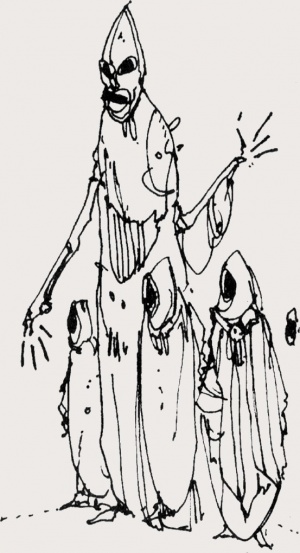
The ship of my passage was captured by pirates calling themselves the "Restless League." They threw over crates from the cargo-hold ~ crates full of arms meant for the Empire at Stros M'kai. And they robbed everyone aboard ~ though their leader, after seeing this, my annotated pamphlet, and guessing my intent let me keep it, telling me "We must not act and speak as if asleep." ~ ??
Tourists have, historically, given wide berth to the Redguard cities outside of those facing the Iliac Bay. Considering the (mostly deserved) reputation of its people, Hammerfell is frequently seen as intolerant of "foreigners," where trespass is dealt with in blood. This is a shame, and a situation that the Emperor seeks to rectify, for Hammerfell itself is a beautiful country. From the twin moonrises over the Alik'r shade-temples to the austere ramparts of Old Hegathe, everywhere there is the appearance of antique splendor. Its people are harsh-- four hundred years of internal conflict and corrupt government have made them so-- but, taken singly, the Redguard is often a masterful work of a man. Perhaps a guiding power like the Empire, steering Hammerfell clear of the foul agents of A'tor's legacy, and protecting her from the avarice of her Elven neighbors (grow weary of pointing these out ~ I trust you will find the rest ~), will bring the same prosperity to her people that it seeks to bring to the world.
Places of Note:
Sentinel
Second capital of Hammerfell, Sentinel sits on the edge of the Iliac Bay. It is most definitely a merchant power, for it sits on a rocky run of hills, and the barren plains behind it offer no good soil before they run into the desert sands of the Alik'r. Its principal street is a vast marketplace stretching from the harbor all the way to the badlands gate. Sentinel Palace is the oldest and largest Redguard architectural monument, quickly built during the Ra Gada firestorm to ward against the Bretons and added to ever thereafter. Currently, this Palace is the headquarters of Provisional Governor Senecus Goddkey, who has been helping to administer the Forebear principalities since Baron Volag's (Rumors persist that this Baron Volag is hiding in the hills with his personal "blood-drinkers", waiting for a sign of weakness in the Empire.) disappearance. Since its Imperial reorganization, Sentinel has become an exotic retreat for the nobility of Daggerfall and Wayrest, who delight in its native cooking, craftsmanship, and the bizarre morality-plays of its Royal Theatre.
Stros M'kai
Formerly the principality of Thassad II's heir, A'tor, Stros M'kai's small island serves as the office of Provisional Governor Amiel Richton, who is charged with the protection and patrol of Hammerfell's barbarous southern coast. Lord-Admiral Richton (Evidently, Richton is breaking down under the pressure of his assignment ~ Stros M'Kai is very important to the Emperor and it is vital that Richton clear its waters of pirates and the sort ~ even the "Restless League" does not realize this (more concerned with sanctity and that mess, I gathered~)) was the officer who defeated Prince A'tor in the Battle of Hunding Bay, and is the latest of a long line of heroes to serve in the Colovian West Navy. Stros M'kai itself would be an unassuming little port, famous only for its Dwemer Ruins, were it not for its presently strategic location near the Cape of the Blue Divide, the waters of the dread Aldmeri Dominion.
The Aldmeri Dominion (of this pamphlete, this regime, this lunacy~) is a relatively recent creation. Formerly divided into the two realms of the Summerset Isles and Valenwood, the Aldmeri Dominion has its origins in CE830, when the heirs of the Camoran Dynasty began to fight over the Valenwood throne. When a faction of the Bosmer (Wood Elves) made overtures of peace to their longtime enemies in West Cyrodiil - territorial concessions in return for Colovian support for the faction's claimant - the Altmer (High Elves) of Summerset invaded the Valenwood Nations. Citing a stewardship clause in a treaty from a thousand years before, the High Elves quickly established a provisional government, the Thalmor, on behalf of their own claimant, Camoran Anaxemes, whose bloodline had struck the pact with the Aldmeri Council in the first place. As the Cyrodilic Empire was still in the shambles of the Interregnum, the Colovians were quickly driven back by the Aldmeri army. The other heirs of the throne were silenced, the Wood Elves thanked their cousins for bringing back stability, and the High Elves reminded Anaxemes the price of Summerset's aid: fifty years' fealty to the King of Alinor. The Aldmeri Dominion was born. (I don't know where to begin pointing out the lies)
| The Scarcity of Elven Writings Much of the blame for this can be laid on the Alessian Order, which was tireless in ferreting out and destroying Elven writings during its long dominance. Today, we are left with the beautiful heresies of the Anuad, surviving only by virtue of their popularity and proliferation, and perhaps a dozen more works of lesser reknown. This, though, does not explain fully the scarcity of Elven letters. We might turn to Dylxexes, an early human scholar, for another answer. After studying the financial records of the Direnni Hegemony, a High Elven merchant family that exploited the human kingdoms of its day, he had this to say: "These [records] may help to explain why so much of Aldmeri literature is forbidden, scorned, or untranslated, for I have seen [their] like before. The Direnni were either exceedingly paranoid or their system of economy so inextricably linked with dangerous theosophist numeral-symbolism that much of what is recorded here requires... sorcerous precautions on the part of the reader. [Hidden magic] is everywhere incorporated in their writings... signs and preternatural runes and [correspondences]... in expenditure columns, even, or margins [that] can be fatal to the uninitiated. Crucial pages were covered with the spittle of the previous translator, who had babbled idiotically over the text for days before catching fire." |
The Thalmor strengthened its hold on the Valenwood Nations during the foundation of the Third Empire. Savage Bosmer tribes skirmished with the Estates along the River Strid, whipped to a frenzy by their High Elven masters. With the Empire now reunified under Tiber Septim, these attacks have subsided; but encampments wait on either side of the Valenwood border, awaiting a decisive battle. On the occasions when the Elves probe the Empire's defenses, the Legions have sent them back in tatters. Indeed, the Colovians have taken to calling their enemy the "Old Mary" Dominion, for the womanly offensives of its Elven soldiers. The situation at sea, however, is another story, and the Dominion terrorizes the southern waters from the Cape of the Blue Divide to the Topal Bay. (! ! !) Their sorcery has made allies of a few Reachmen, the Maormer of Pyandonea, and, as of this writing, perhaps even the Elsweyr Confederacy. Though no formal declaration of war has been made, Tamriel is divided between the Empire and the Elder Races, and Tiber Septim has made it known to the Thalmor that he is the True Emperor of Cyrodiil, and heir to all of its former holdings. The Elves of Tamriel have yet to answer.
Considering we have endured their offenses for two thousand years, we know surprisingly little about the Aldmeri. (Only Morrowind, under Skyrim domination during the First Empire, and open to travel and trade during most of the Common Era, is somewhat better known.). The Elves of High Rock and Cyrodiil were either wiped out long ago or displaced into obscurity. As for the Elves of the Dominion, our knowledge of their regions is limited to brief Imperial occupations, or to the translations we have of their literature (see Sidebar).
| The Great Apes of Valenwood The Great Apes, or Imga, are native beastfolk of Valenwood. They see the High Elves as their lords and masters, and as a portrait of an ideal, civilized society. Great Apes go to desperate measures to emulate the High Elves: they wear capes, practice with the dueling sword, and attempt to speak with perfect enunciation and courtly manners despite their gravelly, baritone voices. Each Imga bears some kind of title, be it Baron, Duke, Earl, or the like, which they use when addressing the members of the Thalmor (needless to say, there are no landowning Great Apes). More extreme Great Apes shave their bodies and powder their skin white to seem more like the High Elves. They often cut themselves in the process, creating the truly pathetic picture of a naked white Ape, skin dotted pink with blood, strutting around the trading posts of Valenwood with mock nobility. The Imga feel that humans are beneath them as lesser beastfolk, and pretend to find their smell exceedingly offensive - a Great Ape holds a perfumed corner of his cape to his nose when Men are around. |
Of particular scarcity is information about either the High Elves or the Summerset Isles. During the Second Empire (My bones chill thinking of such rampant human trespass) ambassadors were allowed only in the capital of Alinor, and thus any description of the Altmeri homeland is confined to that city alone, and elsewhere (see sidebar - Alinor). Furthermore, we can offer only this brief but reliable account of the High Elven people. It comes from the journals of Eric of Guis, Reman's emissary to the Altmer, who (Eric of Guis~
Does Grandfather remember this fool?') lived among them ca. 1E2820:
"High elves consider themselves to be the only perfect race. Over hundreds of generations they have bred themselves into a racially pure line, and are now almost identical to one another in appearance. The theory that the High Elves do not reproduce as quickly or as often as humans is false. Rather, and to my horror, they kill nine out of ten babies born to them in their obsession for purity.
"The Altmer despise other Elves as unsophisticated churls and barely consider the non-Aldmeri races at all. They pay their Imperial tithes, I'm sure, not for fear of war with the humans but rather to keep an invasion from "infecting" their islands.
"Breeding outside the pure line is a terrible, unthinkable crime, and taken as prima facia evidence of the tainted blood of the individual in question- if they were, they wouldn't have the impulse to do it. Exile to the mainland is regarded as equivalent to a death sentence, since there is no purpose in living outside their ideal society.
"They have a high regard for order and gravitate naturally towards wearing uniforms and speaking in formal patterns. Their trees and their livestock have been bred to be as standard and ideal as they are. They have no real names of their own, only combinations of numbers that, when spoken aloud, sound to human ears as such. They feel no real tenderness for one another and have no concept of compassion.
"They are decadent and self-obsessed, and prize form and their own brand of manners or style as their main value. Aware of their aristocratic position, they surround themselves with riches and treasures, the works of great artists and the finest of everything, but have no real appreciation for any of these things. Each of them is concerned solely with himself, and as a result they do no real socializing; they meet and hold courts only to demonstrate their importance and power to each other. Rarely do they speak to the human ambassadors of Cyrodiil; when they do, their speech is full of riddles, or spell-words that enchant one to a satisfied madness."
Valenwood was claimed as a wasteland province of the Second Empire, and its geography is partially described in several Imperial surveys. Valenwood is noteworthy in that it has no cities or townships built by the Wood Elves themselves. Their strict "Green Pact" prohibits the use of wood or other vegetable derivatives as building materials, and they are too improvident to learn the use of stone. The Wood Elves permitted a few roads to be built by the Second Empire, but neglect their maintenance, as the Bosmer do not need roads to move easily through the thickest forest; these roads would be now overgrown were it not for the High Elves of the Thalmor, who have repaired and widened them for rapid passage of their arms to and from the coast. Much of the region is impenetrable mangrove and coastal rain forest, with few grasslands or glade areas until further north near the Strident Coast. Many of the human trading posts established by the Second Empire have been abandoned or claimed by the beastfolk - Centaurs, Orcs, and Imga - that share the forests with the Bosmer tribes. Humans, in general, have learned not to intrude in the forests of Valenwood. While they once depended entirely on the annual Stridmeet caravans of the Colovian West, the Wood Elves now rely entirely on the sea piracy of the Dominion for whatever they require from the outside world.
| Alinor A forbidden city for nearly fifty years, Alinor is both capital of the Summerset Isles and the heart of the Aldmeri Dominion. Human traders were only allowed at its ports, and they described the city as "made from glass or insect wings." Less fantastic accounts come from the Imperial emissaries of the Reman Dynasty, which describe the city as straight and glimmering, "a hypnotic swirl of ramparts and impossibly high towers, designed to catch the light of the sun and break it to its component colors, which lies draped across its stones until you are thankful for nightfall." Falinesti The walking city of the Bosmer king, Falinesti is south in the summer and north come Hearth Fire. It is the largest of Valenwood graht-oaks, whose magic was invoked at the dawn of recorded history. The Camaron throne is somewhere in the highest branches, as are numerous other natural dwellings. Wood Elves climb about its surface like termites, or carefully swing from level to level by means of thorny vines. Humans have generally been too unsettled by the city to stay there long, though Great Apes and Orcs are common. The Thalmor has decided to change the capital of Valenwood from Falinesti to Elden Root for the duration of the Aldmeri Dominion. |
Concerning the Wood Elves as a people, we must again turn to the prolific Eric of Guis. After a grateful dismissal from the Court of Alinor, he stayed with the Bosmer for a time at the capital city of Falinesti, during its summer migration. As the city strode along the coastal region of the Cape, Eric of Guis recorded much about Valenwood culture:
"No less abhorrent are the Bosmer than their kin at Summerset, but they are far more cooperative. The Wood Elves love the current human activity because it makes them feel important.
"They are exclusively and religiously carnivorous. They cannot, or will not, eat anything that is plant-based. They eat game, beastfolk, each other, or meats imported from other regions. This part of the Green Pact is known as the Meat Mandate, and, among its other rules, it requires that a fallen enemy must be eaten completely before three days pass. The family members of the warrior that slew the enemy may help him with his meal. Needless to say, the Wood Elves do not like to engage in large battles if they have not undergone a suitable starvation period.
"Though they are excellent archers, the Green Pact forces their bowyers and fletchers to use bone or similar materials, or to buy bows and arrows from other cultures. The use of woodcrafts created by another race is not forbidden, nor is the sale of their own Valenwood timber as long as it is collected by a non-Bosmeri.
"The Wood Elves, of course, cannot smoke anything of a vegetable nature. Bone pipes are common, however, and are filled with caterpillars or tree grubs.
"For a brief time the Colovian armies used Wood Elf archers, as in the War of Rihad two years past. The Bosmer proved to be too undisciplined and prone to desertion for further use. They would sometimes walk into the shade of a single tree and vanish. Their forest-coupling skills are remarkable. The title of their most famous poem, the Meh Ayleidion, means "The One Thousand Benefits of Hiding."
"At the trading posts of the Empire, the Wood Elves become very happy. Some creations of carpentry delight them to no end. Most of it has never occurred to them. They bring their own trade items: hides, river pearls, finger-bone charms made from the still-magically-charged hands of their dead wizards. They often buy woodcrafts that they have no use for or whose use they never bother to find out. Some of the bravest Wood Elven warriors use wagon wheels as shields, or as (they think) impressive headgear.
"While sometimes amusing, the Bosmer have a bestial side. They can resort to animal shapes if they need to, or water. Their most dreaded transformation is the Wild Hunt, which killed King Borgas for the "iniquities" of his Alessian faith. The Wild Hunt is a pack of shifting forest-demons and animal-gods, thousands strong, which sweeps through the countryside killing everything its path. The Wood Elves do not like to talk about the Hunt, and I gather they do not feel proud of this power at all-Gomini, my Bosmer companion of late, tells me that the Hunt is used for justice, but that also, "every monster in the world that has ever been comes from a previous Hunt. Those Bosmer that go Wild, they do not return.""
The traveler is advised to avoid the lands of the Aldmeri Dominion. Though the Thalmor have representatives at the Imperial City, and the Cyrodilic Grand Vizier Zurin Arctus is meeting with the King of Alinor, contact with the Bosmer and Altmer are often disagreeable to the common Imperial citizen. Avoid their books and magic. Wear the permitted weaponry when near their borders. If you are manly and able, apply for service in the Legions.
En cours...
